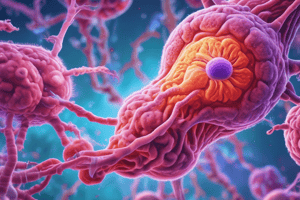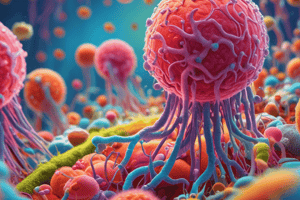Podcast
Questions and Answers
What is the most likely consequence of untreated chlamydial infection in women?
What is the most likely consequence of untreated chlamydial infection in women?
- Infertility and ectopic pregnancy (correct)
- Elevated blood pressure
- Enhanced immunity to bacterial infections
- Increased risk of infections with other STIs
Which of the following is the primary site of infection for chlamydia in females?
Which of the following is the primary site of infection for chlamydia in females?
- Vagina
- Cervix (correct)
- Fallopian tubes
- Urethra
What is a common symptom of chlamydial infection in men?
What is a common symptom of chlamydial infection in men?
- Rash on the chest
- Nasal congestion
- Continual headaches
- Painful swelling in the testicles (correct)
What is the preferred medication for treating chlamydial infections?
What is the preferred medication for treating chlamydial infections?
How can chlamydia be transmitted from a mother to her child?
How can chlamydia be transmitted from a mother to her child?
Which of the following conditions can result from pelvic inflammatory disease (PID)?
Which of the following conditions can result from pelvic inflammatory disease (PID)?
Which of the following statements about rickettsial infections is true?
Which of the following statements about rickettsial infections is true?
What type of organism causes chlamydia?
What type of organism causes chlamydia?
What is one significant consequence of chlamydia during pregnancy?
What is one significant consequence of chlamydia during pregnancy?
Which demographic is at the highest risk of contracting chlamydia?
Which demographic is at the highest risk of contracting chlamydia?
Which symptom is NOT commonly associated with chlamydia in men?
Which symptom is NOT commonly associated with chlamydia in men?
What is a distinguishing feature of mycoplasmas compared to other prokaryotes?
What is a distinguishing feature of mycoplasmas compared to other prokaryotes?
What is a common misconception about individuals with chlamydia?
What is a common misconception about individuals with chlamydia?
Which of the following species of Mycoplasma is known to cause disease in the respiratory tract?
Which of the following species of Mycoplasma is known to cause disease in the respiratory tract?
What laboratory test is essential for diagnosing chlamydia?
What laboratory test is essential for diagnosing chlamydia?
Which of the following best describes a typical treatment approach for chlamydia?
Which of the following best describes a typical treatment approach for chlamydia?
Mycoplasmas are often referred to as the 'crabgrass' of cell cultures due to their:
Mycoplasmas are often referred to as the 'crabgrass' of cell cultures due to their:
What should be a priority to prevent chlamydia during pregnancy?
What should be a priority to prevent chlamydia during pregnancy?
Which statement regarding Mycoplasma species affecting fertility is correct?
Which statement regarding Mycoplasma species affecting fertility is correct?
Which of the following best describes the appearance of Mycoplasma colonies on agar?
Which of the following best describes the appearance of Mycoplasma colonies on agar?
Which statement regarding chlamydia testing and treatment is true?
Which statement regarding chlamydia testing and treatment is true?
What kind of medium is typically used for routine culture of Mycoplasma?
What kind of medium is typically used for routine culture of Mycoplasma?
Which Mycoplasma species is specifically mentioned as linked to increased infant mortality rates?
Which Mycoplasma species is specifically mentioned as linked to increased infant mortality rates?
Which characteristic is true of Mycoplasma species with regards to oxygen?
Which characteristic is true of Mycoplasma species with regards to oxygen?
Which demographic group has the highest risk factors for infections caused by Rickettsia?
Which demographic group has the highest risk factors for infections caused by Rickettsia?
What is the primary method of transmission for Rickettsia species?
What is the primary method of transmission for Rickettsia species?
Which antibiotic is first choice for treating rickettsial infections in children?
Which antibiotic is first choice for treating rickettsial infections in children?
What characterizes Typhus fever?
What characterizes Typhus fever?
Which of the following statements about Rickettsia species is false?
Which of the following statements about Rickettsia species is false?
Which method is typically used for cultivating Rickettsia species?
Which method is typically used for cultivating Rickettsia species?
What common symptoms might indicate a rickettsial infection?
What common symptoms might indicate a rickettsial infection?
What type of rash is commonly associated with Typhus fever?
What type of rash is commonly associated with Typhus fever?
Study Notes
Mycoplasma
- Mycoplasmas are the smallest self-replicating bacteria, lacking cell walls and belonging to the class Mollicutes.
- They survive with minimal organelles: a plasma membrane, ribosomes, and a double-stranded circular DNA genome.
- Mycoplasmas can develop spherical to filamentous shapes and are resistant to many antibiotics due to their lack of cell walls.
- Believed to have evolved from Gram-positive bacteria, they are closely related to clostridia.
- Known as the “crabgrass” of cell cultures, mycoplasmas cause persistent infections that are hard to detect and treat.
- Pathogenic species include Mycoplasma pneumoniae (respiratory infections), Mycoplasma genitalium (pelvic inflammatory diseases), and Ureaplasma urealyticum (nongonococcal urethritis).
- Mycoplasmas can exist without oxygen, and colonies exhibit a distinctive fried-egg shape on agar.
- Routine growth medium for mycoplasmas typically includes heart infusion, peptone, yeast extract, salts, glucose/arginine, and horse serum.
Mycoplasma pneumonia
- Mycoplasma pneumonia (MP) is a contagious respiratory infection affecting nearly 2 million Americans annually.
- Spread through respiratory fluids, it frequently leads to epidemics.
- Mycoplasma and Ureaplasma species are not part of normal vaginal flora; some are sexually transmitted.
- Mycoplasmas can negatively impact fertility; M. hominis has been linked to male sterility.
- Risk factors for infection include elderly individuals, immune-compromised patients, those with lung disease, and children under five.
- First-choice antibiotics for pediatric cases are erythromycin, clarithromycin, and azithromycin; adults may receive doxycycline, tetracycline, or quinolones.
Rickettsia
- Rickettsia consists of non-motile, Gram-negative, pleomorphic bacteria that require eukaryotic host cells for survival.
- They can appear as cocci, rods, or thread-like forms and are obligate intracellular parasites.
- Rickettsia is commonly found in ticks, lice, fleas, and mites, making its culture reliant on living hosts.
- Capable of causing diseases such as Rocky Mountain spotted fever, epidemic typhus, and murine typhus, Rickettsia is transmitted via vector bites or feces.
- Once inside the body, Rickettsia spreads through the bloodstream, affecting endothelial and vascular smooth muscle cells.
Typhus Fever
- Typhus fever is characterized by symptomatic fever, headache, and a rash that begins centrally and spreads outward.
- It is associated with insect vectors like body lice, mites, and fleas.
- Rash is observed in 20-80% of cases and varies in type (macular, papular, or purpuric).
Diagnosis and Treatment for Rickettsial Infections
- Diagnosis can be challenging due to overlapping symptoms with other diseases like dengue.
- Key indicators include fever, rash (usually appearing after day 3), and history of vector exposure.
- Early treatment with doxycycline or tetracycline is effective, and prevention focuses on controlling vector populations.
Chlamydia
- Chlamydia are Gram-negative, anaerobic bacteria that are intracellular obligates, primarily infecting humans.
- Chlamydia trachomatis is the most prevalent sexually transmitted infection globally, notably affecting the cervix in females.
- Complications include cervicitis, pelvic inflammatory disease, and a higher risk of infertility and ectopic pregnancy in women.
- In men, chlamydial infections can lead to urethritis and epididymitis, among other complications.
- Transmission occurs through sexual contact, including vaginal, anal, or oral sex, and from infected mothers to newborns.
- Symptoms may include abnormal vaginal discharge, burning during urination, and lower abdominal pain.
Complications and Treatment for Chlamydia
- Chlamydial infections can lead to severe conditions such as pelvic inflammatory disease (PID) and liver inflammation.
- Preferred treatment is azithromycin; alternative medications include doxycycline and levofloxacin.
- Safe sex practices, along with early diagnosis and treatment, are key to prevention.
Studying That Suits You
Use AI to generate personalized quizzes and flashcards to suit your learning preferences.
Related Documents
Description
Explore the unique characteristics of mycoplasmas, rickettsia, and chlamydia in this quiz. Learn about their structure, functions, and differences from other bacteria. This content is essential for understanding these unusual microorganisms in biomedical science.


